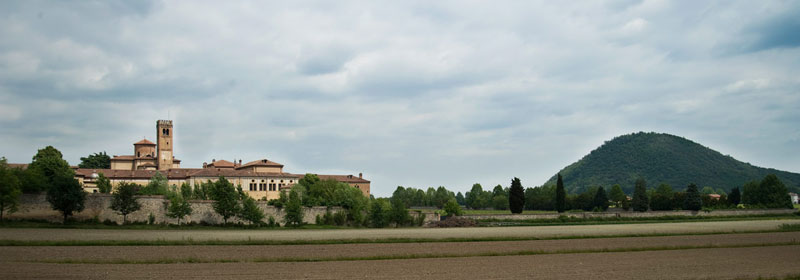





|
|||
Middle AgeFrom “Longobardi” period to 11th century A.D.The centuries following Gothic wars (535-553 A.D.) and Lombard conquest (end of the 6th – beginning of the 7th century A.D.) are characteristic of a drastic shortage of written sources, regarding both Euganean Hills and Padua. Documents went back to mentioning Euganean and Paduan territory only in the 11th century: it is archaeology that helps us to throw light on the history of this period. The foundation of the Castello di Monselice dates back to the second half of the 6th century, probably built by Byzantines in reply to the advance of the Langobardi. The fortune of the castle was nevertheless decreed by the conquest of Padua, brought down in 601 A.D. by the Lombard king Agilulf. Monselice soon became the new politic centre of the area, holding the role once played by the ancient “Patavium”; in Early Middle Ages, the town probably had its own administrative district (“iudiciaria” or “comitatus”), also including the Euganean hot springs. The thermal area had to be – at least partially – subjected to public control, while the monastic institutions of the time gave a great importance to thermal resource for aid and charitable purposes. A later source says that, in the second half of the 10th century, a private citizen would have remised to the well-known Abbazia di Farfa, in Latium, a church located in Abano, to which was probably annexed a “xenodochium” – a hospice to welcome needy and sick people. As regards the area where Montegrotto Terme currently stands, if the written sources are scarce, archaeology instead proves the vitality of the settlement between 9th and 11th century A.D., as it emerged from the excavation of the archaeological site at Via Neroniana. The period around the year One ThousandAn atmosphere of general insecurity got about during the 9th century A.D.: this background was determined both by power struggles within the “Regnum Italicum” and by the Hungarian forays which, since 899, had spread terror in the whole Po valley, also destroying the city of Padua. These circumstances underlay the so-called “process of castelization”: : between 9th and 10th century A.D., on Euganean Hills as well as elsewhere, the number of castles multiplied. These fortified structures served not only as dwelling place for the local lords and hub of attraction for rural population, but also as a military instrument for the control of the territory.
The castle of Rocca Pendice was built during the 11th century A.D. on bishop’s initiative, on the same hill where the fortress of Castelnuovo (presumably more ancient) rose. Later on, in 1107, Uberto, also known as Maltraverso “de Montebello” (bound to the Paduan bishop Sinibaldo), founded the Monastero di Praglia. From the second half of the 13th century on, various settlements are also attested in other places of the Euganean thermal area: for example, the villages of Villaranza and Villatorta, a “motta” on which stood a “domus” with tower, a fen and a bath, and several buildings scattered in the countryside. In their entirety, these attestations refer to a medieval landscape with some significant sites (fortifications, baths, worship places) inserted in an agricultural context marked by a toponymy that can be related to morphological and pedological peculiarities (“Montealto”, “Montaleo”, “Vallada”, “Rodula”, “Calcaria”, “Crearium”), as well as to cultivations (“Vignale”, “Vignà”, “Pratolongo”) and wood areas (“a Buscaleis”, “Buschis Planis”). In the first centuries after the year 1000, in conclusion, lordly and monastic powers equally concurred in redrawing Euganean landscape, transformed by the cultivation of more and more extended areas where wine was primarily produced – perfectly integrating the cereal production of the plain surrounding Padua. For the inhabitants of the city, the Hills were considered a world apart, with proper environmental and economic features; they were often improperly called “monti”, and mentioned in written documentation under the name “Pedevenda”. The appellation “Euganei” became popular only from the 14th century on, under the influence of Paduan cultured circles.
The Venetian period (15th – 18th century A.D.)Paduan bulwark against Vicenza and Este, the Euganean Hills attracted the attention firstly of the Commune and secondly of the seigniory of the Carraresi; this interest was due not only to the economic potential connected to agricultural and farming exploitation, but also to the exceptional resource of natural thermal water. Written documentation gives us the picture of a territory plenty of more or less structured pools and “sudatoria”, facilities that allured a larger and larger number of visitors. Local statutes regulated the “steam of tourists”, and set rules for the maintenance of the structures and their periodic cleaning.Towards the end of the Middle Age, the Euganean thermal area was attended not only for the healing properties of its natural hot water, but also for taking relaxing baths – soon becoming a sort of “hotel business”. Following the conquest of Padua and all its territory – included Euganean Hills – in 1405, the Serenissima Republic of Venice incentivized and safeguarded the thermal tourism and an even more considerable number of visitors of Transalpine origin (mainly from Germany) contributed to the development of the area. A document dating back to 21st March 1488 offers us a vivid inside view of the atmosphere that could be found in Abano and Montegrotto at that time: an emissary of Ercole I d’Este contacts a local hotelkeeper in order to guarantee his lord and all his retinue proper conveniences and privacy. As a matter of fact, the Duke of Ferrara got ready to visit Abano to avoid the late spring heat of the Po valley, anxious to enjoy the coolness of the Hills and the tasty produce of the land. 
|
|||
|
|
|||